4 October 2024
Between the rise of artificial intelligence and the proliferation of “fake news,” living in the 21st-century can sometimes feel a bit surreal. That is why there is perhaps no better time to revisit the 20th century’s Surrealism movement, never mind that 2024 marks 100 years since the publication of André Breton’s pivotal Manifesto of Surrealism in which the French writer and poet called for a new kind of art that is guided by the unconscious and “free from any control by reason.”
To celebrate the centenary of what became a huge cultural movement that still influences artists today, the Centre Pompidou in Paris has mounted a sprawling multidisciplinary exhibition that not only showcases the French roots of Surrealism, but its global reach. Curated by Didier Ottinger and Marie Sarré, the show features over 500 artworks and objects, ranging from paintings, drawings to sculptures, and poems to manuscripts.
Inspired by the labyrinthine structure of Surrealist exhibitions in the past, visitors follow the exhibition through a spiral layout. On special loan from the Bibliothèque nationale de France, the original manuscript of Breton’s Manifeste du surréalisme is the starting point to the exhibition, with a surrounding audiovisual installation that explores the origins and significance of the manifesto, setting the dreamlike tone for the rest of the show.
Breton was influenced by the works of Sigmund Freud, particularly the ideas surrounding the unconscious mind, dreams, and free association. He sought to create a new art movement that explored these ideas, stating, “I believe in the future resolution of these two states, dream and reality, which are seemingly so contradictory, into a kind of absolute reality, a surreality.”
The exhibition layout is divided into 13 thematic sections, each exploring different facets of Surrealism. These range from the literary influences that shaped the movement, such as the works of Lautréamont and Lewis Carroll, to the mythical and fantastical elements that became central to Surrealist imagery—dreams, the philosopher’s stone, and forests, amongst many more. Reality and fantasy have been blurred within these exhibition walls, creating a space where the ordinary merges into the extraordinary.
In true Surrealist fashion, the exhibition features a wide range of media, including paintings, drawings, films, photographs, and literary documents. Many iconic works are on display, loaned from international collections. These include Salvador Dalí’s The Great Masturbator from Madrid’s Museo Reina Sofía, René Magritte’s Personal Values from the San Francisco Museum of Modern Art, Max Ernst’s The Large Forest from the Kunstmuseum in Basel, and Joan Miró’s Dog Barking at the Moon from the Philadelphia Museum of Art. The works provide a comprehensive overview of the movement’s diversity, in styles and themes.
In addition to showcasing well-known male artists, the exhibition spotlights the long-overlooked contributions of women to Surrealism, mirroring a wider trend both in museums and the art market. To wit: Just this spring, Leonora Carrington’s Les Distractions de Dagobert (1945) set an auction record for the Surrealist painter when it sold for $ 28.5 million at Sotheby’s, obliterating the artist’s previous record of $3.3 million set just two years ago.





